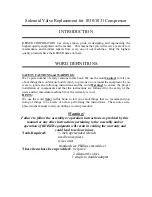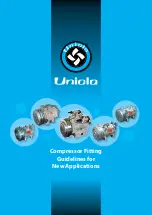
F-1031, Section 2416
Page 4 of 23
E. Compressed Air Foam Operations
Follow the instructions above for foam solution operations. Safe operations dictate the presence of
foam concentrate in the water stream prior to the injection of compressed air. If foam concentrate is not
present, a condition known as “slug flow” will occur. This is where unmixed water and air is discharged
through a nozzle in an erratic manner.
Set water discharge pressure at the desired level. Discharge pressures for compressed air foam
operations typically range between 80 and 120 PSI in a flow state.
NOTE:
Compressed air foam does not have the hydraulic characteristics of plain water or foam
solution. Therefore, standard pump hydraulics practices do not apply to CAFS operations.
•
Engage the air compressor by moving the PTO switch to the “ON” position.
•
Move the Auto-Sync controls to the AUTO / RUN positions. Air pressure as shown on the air
pressure gauge should rise to within plus or minus 5% of the water discharge pressure. The Auto-
Sync system will balance the air and water pre or - 5% throughout a range of 40 PSI up to
150 PSI.
•
Set proportioner at 0.2% - 0.6% for normal Class A combustibles.
The type and brand of foam concentrate used and the tactical objective, dictate proportioning rates.
•
Open desired discharge valve(s). The foam expansion ratio is set by controlling the amount of foam
solution entering the discharge stream. High solution flows restrict the amount of air admitted and
result in lower expansion or “wet” foam. To produce higher expansion or “drier” foam, simply gate
back the amount of solution admitted.
•
Fully open the air valve(s) to the desired discharges.
•
Adjust the solution flow to produce the desired foam consistency.
Foam is formed during the transition through the hose. To produce acceptable finished foam,
sufficient hose length must be provided on the discharge. Refer to Section “Suggested Guidelines
for the Production of Mid-Range Compressed Air Foam”, for minimum hose lengths for CAFS
operations.
WARNING
Nozzle reaction force is significantly increased at the time the nozzle valve is opened in
compressed air foam operations. OPEN CAFS NOZZLES SLOWLY!
F. Compressed Air Only Operation
Follow instructions for water pumping operations without opening discharge valves. Air compressor
cooling is via water that is circulated by the fire pump through the compressor cooler and returned back
to the booster tank. During this operation, time is limited by the amount of available cooling water. The
water in the booster tank will eventually become heat saturated and ineffective at cooling the air
compressor. Watch the compressor temperature gauge closely! Maximum 250° F. Compressor
system overheat is also indicated by the panel mounted warning light and alarm.
•
After engaging the fire pump, ensure that the water pressure as shown on the panel mounted
master pressure gauge rises.
•
Engage the air compressor PTO
Содержание 80-P
Страница 19: ...F 1031 Section 2416 Page 19 of 23 Figure 7 80 SP...
Страница 20: ...F 1031 Section 2416 Page 20 of 23 Figure 8 Basic CAFS Schematic...
Страница 21: ...F 1031 Section 2416 Page 21 of 23 Figure 9 Air Schematic w Manual Auto sync...
Страница 22: ...F 1031 Section 2416 Page 22 of 23 Figure 10 Hydraulic Schematic...





































